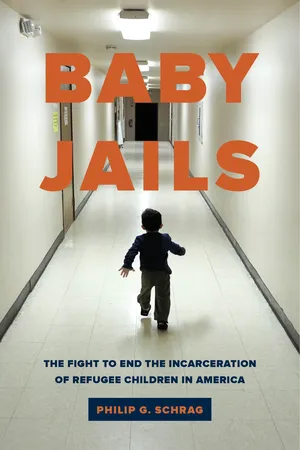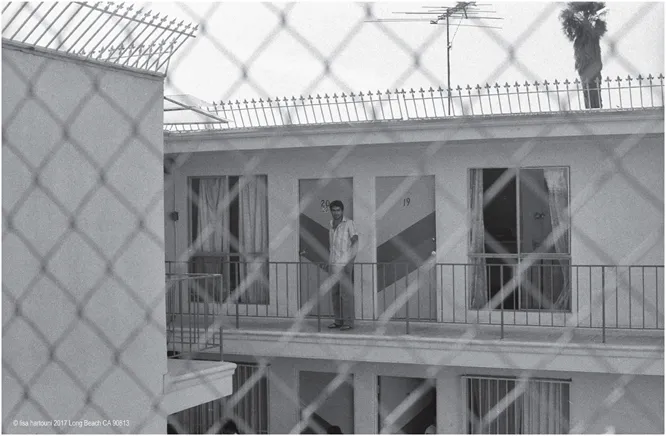![]()
1
Jenny Flores
1985–1988
HAROLD EZELL’S JAILS FOR CHILDREN
In 1985, fifteen-year-old Jenny Lisette Flores traveled alone from war-torn El Salvador to the United States, hoping to be reunited with her mother, who was living in California. Like many children who had fled the civil war in her country, she had no visa. The Immigration and Naturalization Service (INS) apprehended her and took her into custody shortly after she crossed from Mexico into California, but she could not be deported until she appeared before an immigration judge to determine whether she had any basis for being allowed to remain in the United States. The judge might find, for example, that she had a claim to U.S. citizenship based on the citizenship of one of her parents, or that she was eligible for asylum. Or the judge might decide that she had no valid claim and should be sent back to El Salvador. But months might pass before such a hearing took place. For children seeking asylum, it could even be several years before their cases were finally concluded, because either the child or the government could appeal a decision that it didn’t like.1
At the time, in most regions of the country, when the INS apprehended an unaccompanied child traveler who had never received permission to enter the United States, it would release the child to a parent or legal guardian in the United States until an immigration court could decide whether the child was eligible for asylum or other relief from deportation. If no parent was present in the country, it could release the child to an “other responsible party” who would promise to bring the child to court when required.2 Such a “party” could be a relative or a child welfare agency. But things were different in the INS’s Western Region, which included California.
The INS Regional Commissioner was Harold Ezell. He had been an executive for Wienerschnitzel International, a hot dog franchising company, before he joined the Reagan administration in the early 1980s.3 He believed that “illegal immigration will destroy what we know as a free society in the next five to ten years” 4 and was “among the first to start the drumbeat against what he called an ‘invasion’ of illegal immigrants.”5 He reportedly stated in a 1985 newspaper interview that some undocumented immigrants should be “skinned and fried” and then deported.6
Notwithstanding the child detention policy in effect elsewhere, in 1984 Ezell had adopted a stricter policy for the release of children apprehended in his region. He decided that in California and the other Western states, which happened to be the location of most of the nation’s unaccompanied child migrants, the INS would routinely release a child who was in deportation proceedings only to a “parent or lawful guardian.” His office would release the child to a different responsible adult only in “unusual or extraordinary cases.” 7 It didn’t consider Jenny’s case unusual or extraordinary. Therefore, Jenny could be detained for as long as it took for her to get a hearing before a judge.
Jenny’s mother would have been happy to be reunited with her, but she was herself undocumented, so she was afraid to report to any INS office or facility, such as the one where Jenny was being held, fearing that both she and her daughter would then be deported to El Salvador, where a civil war was raging. Her fear was reasonable, because INS officials acknowledged that undocumented adults who showed up to claim their children were “subject to arrest and deportation.” 8 In fact, undocumented mothers who went to INS jails to post bond9 for their children were sometimes put into deportation proceedings along with their offspring.10 Decades before the phrase made headlines, Jenny and others like her were subjected by immigration authorities to family separation.
The INS detention center at the Mardi Gras Motel, 1985.
But Jenny’s mother had an alternative. Jenny’s aunt and uncle lived in Los Angeles and were willing to look after Jenny.11 The uncle was a U.S. citizen, and the aunt had a green card. Because Jenny had been captured in the Western Region, however, the INS would not release her to someone other than a parent.
Jenny was not in an ordinary jail. The INS had hired a private for-profit contractor, Behavioral Systems Southwest, to house detainees in Los Angeles.12 That company had taken over the Mardi Gras Motel in Pasadena, “drained the swimming pool, covered the front of the property with chain-link fence, and strung up concertina wire.”13
Male and female adults and children inhabited this makeshift jail. The children mixed freely with the adult detainees. Jenny shared sleeping quarters with seven other children and five adult women, none of whom were related to her. Like her fellow detainees, she was given no educational instruction or recreation and no reading materials except some English-language magazines that she could not understand.14 Visitors were not allowed.
The children at several of the other INS jails in California and Texas fared even worse. They were strip-searched when they first arrived and when visited by anyone other than lawyers.15 At one detention center in Texas, girls were vaginally and rectally searched as well.16 At another large detention facility for immigrants in Southern California, the staff would “bring minors into the gym every morning, erect a screen between boys and girls, and search everyone . . . [though they] never found anything in body cavities.”17
When the INS first took Jenny into custody near the border, on May 15, 1985, she had refused to sign any documents without the advice of a lawyer. The INS officials told her that “all Salvadorans were idiots and pubic hair.” When she asked where she could remove the fingerprint ink from her hands, an official told her to wipe them on her face, and she complied; the official then laughed at her. Eventually she was transferred to the Mardi Gras Motel. A doctor who examined her after she had been there for two months concluded that the stress of her confinement had resulted in “intermittent preoccupation with death, anorexia and depression.”18
Jenny was one of about five thousand children detained by the INS each year in the late 1980s, most of whom did not have lawyers.19 Many of them were sixteen or seventeen years old, including teenaged boys who had fled from violence associated with military forces. One such youth was “Francisco” (not his real name). When he was eight years old, Sandanista soldiers in Nicaragua had killed Francisco’s father, older brother, grandfather and uncle. His mother sent him to Honduras, where he lived on the streets before fleeing to the United States at the age of seventeen. Another boy saw his parents and three sisters shot in a village square; he had walked from El Salvador to Texas to escape the same fate.20
Some of the children in INS custody were much younger. In 1988, for example, the Border Patrol picked up three Honduran girls, ages seven, five, and four. The oldest one had “a tattered slip of paper in her pocket” with a Miami phone number that turned out to belong to the parents of the younger children.21
Jenny Flores was unusually lucky, however, because she was only three degrees of separation away from a lawyer who could make a difference. Imprisoned with her was Alma Cruz, the twelve-year-old daughter of Alma Aldana, a housekeeper for the actor Ed Asner, who had starred in The Mary Tyler Moore Show. Like Jenny, Alma Cruz was being held in the motel because Aldana, who was also undocumented, was afraid of claiming her.22 Asner knew that he could help to solve the girls’ problem by calling an attorney whom he knew well.
PETER SCHEY
A vocal critic of the Reagan administration, Asner had been active in promoting peace in Central America and had co-founded an organization known as Pax Americas to lobby for an end to the region’s civil wars.23 He also had been involved in protests against the administration’s efforts to deport Central American refugees. In connection with one such protest, at which arrests were expected, Asner had consulted with Peter Schey, a lawyer who had founded the National Center for Immigrants’ Rights, which later became the Center for Human Rights and Constitutional Law. To help his housekeeper and her daughter, Asner called Schey.24
Schey had dedicated his legal career to the defense of immigrants. His father, a Jewish opponent of the Nazis, had fled Europe in 1938, on one of the last planes from France to England. He had ended up in South Africa, where Peter was born in 1947. As a young teenager, Peter participated in protests against apartheid. In 1962, when opposition to apartheid had become too dangerous even for white activists, the family moved to San Francisco.25
Schey was arrested in a protest against the Vietnam War while he was an undergraduate at Berkeley. He went on to study at the California Western School of Law in San Diego, where he received his law degree in 1973. While in law school, Schey enrolled in a legal aid clinic. In his first case, he discovered that the San Diego County hospital was notifying the Border Patrol when an undocumented pregnant woman wanted to give birth there. The Border Patrol would then deport the woman to prevent her baby from becoming a U.S. citizen. Schey threatened to sue the hospital. As a result, the hospital stopped cooperating with the Border Patrol.26
After finishing law school, Schey began to represent immigrants, first in San Diego and then in Los Angeles. This work quickly became full-time. His first class action was a successful suit against the INS to force it to provide everyone who was in deportation proceedings with a list of free local legal services.27 Over the years, he initiated other important class actions on behalf of Central American immigrants and refugees. In the late 1970s he brought a case against the Houston Independent School District, the largest school district in Texas, challenging its denial of secondary education to undocumented children. He argued that refusing to educate these children was a denial of the equal protection guaranteed by the United States Constitution. While the suit was pending, Schey discovered that state officials were getting federal funding for migrant children that they had expelled from school.28 The case was consolidated with a similar suit in another district, and it went all the way to the Supreme Court.29 In 1981, he was one of two lawyers who argued for the children in the Supreme Court. By a 5–4 vote, the justices agreed that the Constitution required states to allow undocumented children to attend public schools.30
THE FLORES CASE BEGINS
After receiving Asner’s call, Schey went to the converted motel in which the children were incarcerated. He was horrified by the prison-like conditions. He quickly contacted the next of kin of severa...


